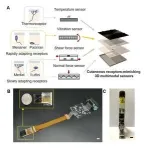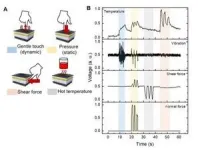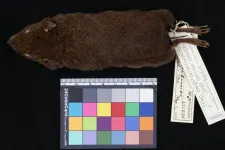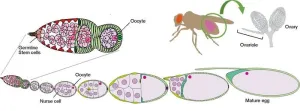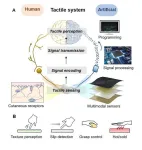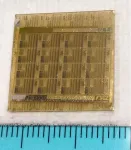(Press-News.org) Artery calcification is almost twice as common in night owls compared to early birds, according to a study from the University of Gothenburg, Sweden. Circadian function appears to be particularly important during the early stages of cardiovascular disease.
Atherosclerosis involves fatty deposits accumulating on the inside of the arteries, making it harder for blood to pass through. The disease develops over a very long period of time and is not noticed until it leads to blood clots causing angina, heart attack, or stroke. Previous research has shown that people with late-night habits have an increased risk of cardiovascular disease, but this is the first study to show how circadian rhythms specifically affect calcification of the arteries.
Coronary artery calcification
The study, which has been published in the journal Sleep Medicine, involved 771 men and women aged between 50 and 64, all of whom are part of the larger population study SCAPIS. The degree of artery calcification in the heart’s coronary arteries was examined using computer tomography. Participants themselves indicated their so called chronotype on a five-point scale: extreme morning type, moderate morning type, intermediate type, moderate evening type, or extreme evening type.
Of the 771 participants, 144 identified as extreme morning types, and 128 as extreme evening types. Among the group who were most alert in the morning, 22.2% had pronounced artery calcification – the lowest proportion of all five chronotypes. The extreme evening type group had the highest prevalence of severe coronary artery calcification, at 40.6%.
The first author of the study is Mio Kobayashi Frisk, a doctoral student at Sahlgrenska Academy, University of Gothenburg:
“Our results indicate that extreme evening chronotype may be linked not only to poorer cardiovascular health in general, but also more specifically to calcification in the coronary arteries calcification and atherosclerosis,” Mio Kobayashi Frisk says.
Preventive treatment
The statistical analysis considered a range of other factors that can affect the risk of atherosclerosis, including blood pressure, blood lipids, weight, physical activity, stress level, sleep, and smoking.
The last author of the study is Ding Zou, a researcher at Sahlgrenska Academy, University of Gothenburg:
“As well as the previously known factors, the individual circadian rhythm also appears to be an important risk factor for atherosclerosis. We interpret our results as indicating that circadian rhythms are more significant early in the disease process. It should therefore particularly be considered in the preventive treatment of cardiovascular diseases”, says Ding Zou.
Self-reported chronotype
Those who had experienced a heart attack were excluded from the study, meaning that the study participants were healthier than the general population. Another weakness identified by the researchers is that participants themselves provided their chronotype.
Each chronotype can be said to have an average time when half of the night's sleep has passed. In a previous study on the same population, though not necessarily the same individuals, this time occurred at 02:55 AM for the extreme morning type group and at 04:25 AM for the extreme evening type group. With the remaining chronotype groups’ mid-sleep times were somewhere in between these extremes.
SCAPIS stands for Swedish CArdioPulmonary bioImage Study. It is a research project within the field of cardiac, vascular, and pulmonary disease. As part of the project, 30,000 randomly selected Swedes aged 50–64 have undergone extensive health examinations: blood sampling, functional tests, and radiological advanced imaging of organs and blood vessels. Six universities and university hospitals are leading and running SCAPIS in close collaboration with the Swedish Heart-Lung Foundation, the study’s main funder.
END
Artery calcification more common in night owls
2023-12-21
ELSE PRESS RELEASES FROM THIS DATE:
Scientists create chiral POM-based frameworks with enhanced stability and catalytic activity
2023-12-21
A team of scientists has created a chiral assembly by blending inorganic polyoxometalates and organic cyclodextrin molecules. Polyoxometalates are a class of nanomaterials with many useful applications. But the use of polyoxometalates as building blocks to construct chiral POM-based frameworks has been a long-stranding challenge for researchers. In this research, the team produced a 3D framework, constructed by coordination assembly. The resulting framework features an interlaced organic-inorganic hybrid layer.
The team has published their work in the journal, Polyoxometalates, ...
Smithsonian-led study reveals five new species of soft-furred hedgehogs from Southeast Asia
2023-12-21
A new study led by scientists at the Smithsonian’s National Museum of Natural History identifies five new species of soft-furred hedgehogs from Southeast Asia.
The study, published in the Zoological Journal of the Linnean Society, used DNA analysis and physical characteristics to describe two entirely new species of soft-furred hedgehogs and elevate three subspecies to the level of species.
The two new species, named Hylomys vorax and H. macarong, are endemic to the endangered Leuser ecosystem, a tropical rainforest in North Sumatra and Southern Vietnam, respectively. The museum specimens that were vital to describing these two new species came from the natural history collections ...
Bugs that help bugs: How environmental microbes boost fruit fly reproduction
2023-12-21
Osaka, Japan – For many of us, when we think of microbiomes, our first thoughts are probably about the beneficial microorganisms that live in our guts. But now, researchers from Japan and US have discovered how the microbes living in fruit flies can enhance their reproduction.
In a recently published study in Communications Biology, the research group has revealed that microbes in the fruit fly microbiome are involved in controlling the germline stem cells that form eggs, as well as subsequent egg maturation, in female fruit ...
Sleep deprivation makes us less happy, more anxious
2023-12-21
Sleep loss does more than just make us tired. It can undermine our emotional functioning, decrease positive moods and put us at higher risk for anxiety symptoms, according to a study published by the American Psychological Association that synthesized more than 50 years of research on sleep deprivation and mood.
“In our largely sleep-deprived society, quantifying the effects of sleep loss on emotion is critical for promoting psychological health,” said study lead author Cara Palmer, PhD, of Montana State University. “This study represents ...
KIMM develops real-time multimodal tactile detection system applicable to robots and wearable devices
2023-12-21
A tactile perception system capable of providing human-like multimodal tactile information to objects like robots and wearable devices that require tactile data in real time has been developed.
The research team led by Research Director Hyuneui Lim of the Nano-Convergence Manufacturing Systems Research Division and Principle Researcher Youngdo Jung of the Department of Nature-Inspired System and Application of the Korea Institute of Machinery and Materials (Chairman Seog-hyeon Ryu, hereinafter referred to as the “KIMM”), an institute under the jurisdiction of the Ministry of Science and ICT, developed a real-time and ...
New 1.5-billion-pixel ESO image shows Running Chicken Nebula in unprecedented detail
2023-12-21
While many holiday traditions involve feasts of turkey, soba noodles, latkes or Pan de Pascua, this year, the European Southern Observatory (ESO) is bringing you a holiday chicken. The so-called Running Chicken Nebula, home to young stars in the making, is revealed in spectacular detail in this 1.5-billion-pixel image captured by the VLT Survey Telescope (VST), hosted at ESO’s Paranal site in Chile.
This vast stellar nursery is located in the constellation Centaurus (the Centaur), at about 6500 light-years from Earth. Young stars within this nebula emit intense radiation that makes the surrounding hydrogen gas glow in shades ...
Light exercise could be the key to reversing childhood obesity linked to sedentariness
2023-12-21
Increased sedentary time as a child through adolescence is directly linked to childhood obesity, but new research has found light physical activity may completely reverse the adverse process.
The study - conducted in collaboration with between University of Exeter, University of Eastern Finland, University of Bristol, and University of Colorado and published in Nature Communications – is the largest and longest follow-up to objectively measure physical activity and fat mass, using the University of Bristol’s Children of the 90s data (also known as the Avon Longitudinal Study of Parents and Children). ...
Are diamonds GaN’s best friend? Revolutionizing transistor technology
2023-12-21
Researchers at Osaka Metropolitan University are proving that diamonds are so much more than just a girl’s best friend. Their groundbreaking research focuses on gallium nitride (GaN) transistors, which are high-power, high-frequency semiconductor devices used in mobile data and satellite communication systems. With the increasing miniaturization of semiconductor devices, problems arise such as increases in power density and heat generation that can affect the performance, reliability, and lifetime of these devices. Therefore, effective thermal management is crucial. Diamond, ...
New study examines the relationship between the rate of wound healing, the circadian rhythm, and ‘hair’ on cells
2023-12-21
Nearly every organism on Earth follows a natural circadian rhythm that is coded by your cell’s clock genes, which do exactly as you suspect from the name: regulate your body’s rhythm on a 24-hour basis. Most cells in mammalian bodies have cilia of some sort, which are hair-like structures that perform a variety of functions such as movement for motile cilia and aiding in structure in function for non-motile, or primary, cilia. The primary cilia also act as a sensory organ for the cell, a function which has illuminated ...
Great British Bake Off Christmas desserts not as naughty as you may think
2023-12-21
Christmas desserts from The Great British Bake Off are more likely to use ingredients that are associated with reductions, rather than increases, in the risk of death or disease, suggests research published in the Christmas issue of The BMJ.
As the holiday season approaches, the age-old debate resurfaces: can we indulge in Christmas desserts without feeling the pang of guilt? Can we look past the negative headlines of what butter and sugar do to our bodies, and enjoy a piece of Christmas cake in heavenly peace?
To answer this Christmas conundrum, researchers set out to determine ...

